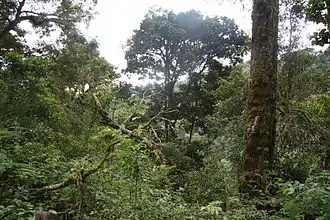La Amistad International Park
The La Amistad International Park, or in Spanish Parque Internacional La Amistad, formerly the La Amistad National Park, is a Transboundary Protected Area in Latin America, management of which is shared between Costa Rica (Caribbean La Amistad and Pacific La Amistad Conservation Areas) and Panama, following a recommendation by UNESCO after the park's inclusion in the World Heritage Site list.
| La Amistad International Park | |
|---|---|
IUCN category II (national park) | |
 The cloud_forest | |

La Amistad International Park area. | |
| Location | Panama-Costa Rica |
| Coordinates | 9°24′25.5″N 82°56′19.7″W |
| Area | 239 km² Pacific, 1753 km² Caribbean |
| Established | September 6, 1988 |
| Governing body | SINAC in Costa Rica |
 Location in Central America | |
| Official name | Talamanca Range-La Amistad Reserves / La Amistad National Park |
| Type | Natural |
| Criteria | vii, viii, ix, x |
| Designated | 1983 (7th session) |
| Reference no. | 205bis |
| State Party | |
| Region | Latin America and the Caribbean |
| Extensions | 1990 |
Geography
The park area is equally split between Costa Rica and Panama, as part of the former La Amistad Reserves of the Talamanca mountain range. It covers 401,000 ha of tropical forest and is the largest nature reserve in Central America; together with a 15 km buffer zone, it represents a major biodiversity resource at a regional (ca 20% of the region's species diversity) and global level.

This is recognized in its strategic position in the Mesoamerican Biological Corridor and its designation as a UNESCO World Heritage Site. Its cross-frontier position gives it unique potential to improve bioregional planning. The park’s buffer zone includes coffee and beef producers and indigenous subsistence farmers. As a consequence of the difficulty of the terrain, the park is relatively unexplored and the only substantial scientific explorations deep into the park have been led by the Natural History Museum London, INBio and the University of Panama in the last 6 years (2003–2008).
In 2006 the UK's Darwin Initiative funded a three-year collaborative project led by the Natural History Museum, London, INBio (Costa Rica) and ANAM (Panama). The aim of the Initiative was to generate baseline biodiversity information for the park and a map of the biodiversity. This involved a series of seven multi-disciplinary and international expeditions to remote parts of La Amistad during which over 7,500 plant, 17,000 beetle and 380 herpetological collections were made and deposited in the national collections of Costa Rica and Panama. These expeditions also led to the discovery of 12 plant species, one dung beetle species, 15 amphibian and three reptile species new to science.
Five species of big cats roam the park: pumas, ocelots, margay, jaguars, and jaguarundis. It has 600 species of birds, including the three-wattled bellbird, resplendent quetzal, yellow-green brushfinch, and bare-necked umbrellabird. Three indigenous tribes – the Naso, Bribri, and Ngöbe-Buglé – also live within the park. These indigenous groups live in small, traditional villages.
See also
- List of World Heritage Sites
- Talamanca Range
- Talamancan montane forests
- Talamancan páramo
References
- C.Michael Hogan. 2008. Isthmian-Atlantic_moist_forests. Encyclopedia of Earth. National Council of Science and the Environment, ed. Cutler Cleveland
External links
| Wikimedia Commons has media related to La Amistad International Park. |